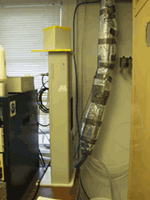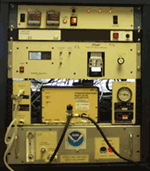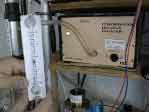More than two years after road access and electrical power to the Mauna Loa Observatory was cut off by lava flows, NOAA staff continue to make critical measurements of the atmosphere and other environmental variables at the remote site.
In 2023, observatory staff installed solar panels at the site and resumed some measurements, including the independent carbon dioxide monitoring programs run by the Global Monitoring Laboratory and Scripps Institution of Oceanography, as well as other atmospheric measurements.
Construction of a temporary road to access the observatory site is anticipated to begin in summer 2025.
Media can contact: Theo Stein (303) 819-7409 (theo.stein@noaa.gov)
Organization(s):
 National Oceanic and Atmospheric Administration (NOAA),
National Oceanic and Atmospheric Administration (NOAA),
Earth System Research Laboratory (ESRL)
What does this program measure?
The aerosol Nephelometer and Particle Soot Absorption Photometer (PSAP) measure the aerosol scattering and absorption coefficients in units of meter-1. The Thermo Systems Incorporated (TSI) unit is a continuous-expansion Condensation Nucleus Counter (CNC). Particle number concentration is determined when particles are exposed to a high super saturation of butanol vapor. This causes the particles to grow to a size where they can be detected optically and counted. The instruments in use have lower particle-size detection limits of 10-20 nm diameter. The Three-Wavelength Nephelometer measures at 450, 550, and 700 nm and has a 2 minute 1/e response time
How does this program work?
- View "ESRL's General Operations Manual" about Aerosol systems details...
- Learn how a Condensation Nuclei Counter Works...
- Learn how a Three-Wavelength Integrating Nephelometer Works...
Aerosol absorption is measured with a Particle Soot Absorption Photometer ( PSAP). This instrument continuously measures the amount of light transmitted through a quartz filter, while particles are being deposited on the filter. The rate of decrease of transmission, divided by the sample flow rate, is directly proportional to the light absorption coefficient of the particles. Newer instruments have been calibrated in terms of the difference of light extinction and scattering in a long-path extinction cell, for laboratory test aerosols. Instruments at the baseline stations ("Aethalometers") have been calibrated by the manufacturer in terms of the equivalent amount of black carbon, from which the light absorption coefficient is calculated assuming a mass absorption efficiency of the calibration aerosols of 10m2g-1.
Integrating Nephelometers are used to determine the light scattering coefficient of the aerosol. These instruments operate by illuminating a fixed sample volume from the side, and observing the amount of light that is scattered by particles and gas molecules in the direction of a photo-multiplier tube. The instruments integrate over scattering angles of 7-170°. A particle filter is inserted periodically into the sample stream to measure the light scattered by gas molecules, which is subtracted from the total scattered signal to determine the contribution from the particles alone. The instruments are calibrated by filling the sample volume with carbon dioxide (CO2) gas, which has a known scattering coefficient.
Why is this research important?
Through scattering and absorption of solar radiation aerosols can cool or warm the Earth’s atmosphere and alter the climate. We are looking to see how the aerosol optical properties change with time, season and long range transport of pollutants.
Are there any trends in the data?
Daily trends are observed between daytime up-slope airflow and night time down-slope flow. Up-slope air has higher aerosol concentrations from both pollution and vegetation, whereas down-slope air is relatively clean and representative of the lower free troposphere. Higher aerosol concentrations are observed in the spring when long range transport of aerosol from Asia is observed.
How does this program fit into the big picture?
What is it's role in global climate change?
The effect of aerosols on solar radiation and climate change has a high uncertainty. Changes in aerosol concentration, size and composition directly alter the heating of the earth’s surface and atmosphere by scattering and absorption of solar radiation as well as indirectly by altering cloud properties. By measuring the scattering and absorption properties we intend to better quantify aerosol optical properties with changes in season and air mass source region. These optical parameters can then be used in global and regional climate models to predict aerosol related climate change.
Comments and References
The Mauna Loa site is one of the few places in the world with continuous measurements of free troposphere aerosol properties. The high altitude site is ideal for observation of long range transport of aerosol because aerosol have much longer lifetimes in the free troposphere than in the lower boundary layer.
Lead Investigator(s):
John A. Ogren
303-497-6210
Patrick Sheridan
303-497-6493
MLO Contact(s):
Matthew Martinsen
808-933-6965 (x228)
Aidan.Colton
808-933-6965 (x233)
Web Site(s)
http://gml.noaa.gov/aero/
Live Aerosol Data
Date Started
1974
Related Programs
Photographs:





(Full Description)
